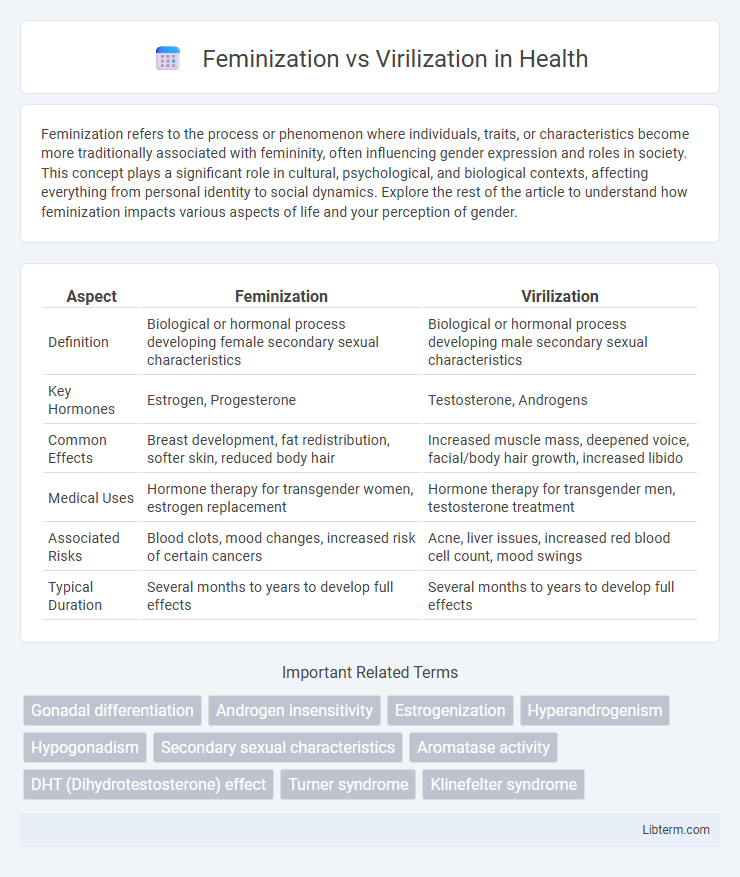Feminization refers to the process or phenomenon where individuals, traits, or characteristics become more traditionally associated with femininity, often influencing gender expression and roles in society. This concept plays a significant role in cultural, psychological, and biological contexts, affecting everything from personal identity to social dynamics. Explore the rest of the article to understand how feminization impacts various aspects of life and your perception of gender.
Table of Comparison
| Aspect | Feminization | Virilization |
|---|---|---|
| Definition | Biological or hormonal process developing female secondary sexual characteristics | Biological or hormonal process developing male secondary sexual characteristics |
| Key Hormones | Estrogen, Progesterone | Testosterone, Androgens |
| Common Effects | Breast development, fat redistribution, softer skin, reduced body hair | Increased muscle mass, deepened voice, facial/body hair growth, increased libido |
| Medical Uses | Hormone therapy for transgender women, estrogen replacement | Hormone therapy for transgender men, testosterone treatment |
| Associated Risks | Blood clots, mood changes, increased risk of certain cancers | Acne, liver issues, increased red blood cell count, mood swings |
| Typical Duration | Several months to years to develop full effects | Several months to years to develop full effects |
Understanding Feminization and Virilization
Feminization and virilization refer to the development of secondary sexual characteristics typically associated with female and male physiology, respectively. Feminization involves traits such as breast development, widening of hips, and redistribution of body fat, primarily influenced by estrogen and other female hormones. Virilization is characterized by increased muscle mass, deepening of the voice, facial and body hair growth, driven largely by androgen hormones like testosterone.
Biological Basis of Feminization
Feminization primarily involves the increased activity of estrogens and the development of female secondary sexual characteristics, driven by the hypothalamic-pituitary-gonadal (HPG) axis regulating hormone secretion. The biological basis centers on the secretion of gonadotropins that stimulate ovarian follicle development and estrogen production, influencing tissue differentiation and morphological changes such as breast development and fat distribution. Molecular mechanisms include estrogen receptor activation within target tissues, promoting gene expression that supports female phenotypic traits.
The Science Behind Virilization
Virilization refers to the development of male secondary sexual characteristics due to increased androgen levels, primarily testosterone and dihydrotestosterone, affecting tissues such as skin, hair follicles, and vocal cords. The science behind virilization involves the activation of androgen receptors, which modulate gene expression responsible for traits like deepened voice, increased muscle mass, and facial hair growth. This process is studied extensively in endocrinology, with implications for conditions like polycystic ovary syndrome (PCOS), adrenal hyperplasia, and androgen-secreting tumors.
Key Differences Between Feminization and Virilization
Feminization refers to the development of female secondary sexual characteristics such as breast growth, wider hips, and reduced body hair, typically influenced by increased estrogen levels. Virilization involves the emergence of male secondary sexual characteristics like deepening of the voice, increased muscle mass, and facial hair growth, often driven by elevated androgens such as testosterone. Key differences hinge on hormonal influence, physical traits developed, and the underlying physiological processes guiding sexual characteristic expression.
Causes of Feminization in the Human Body
Feminization in the human body primarily results from an imbalance in sex hormones, particularly elevated levels of estrogens or reduced androgens. Causes include endocrine disorders such as hyperestrogenism, liver disease affecting hormone metabolism, and use of certain medications like antiandrogens or exogenous estrogens. Genetic conditions like Klinefelter syndrome and tumors in estrogen-producing tissues can also lead to feminization by disrupting normal hormone regulation.
Causes of Virilization in the Human Body
Virilization in the human body results primarily from excessive androgen production or exposure, often caused by adrenal gland disorders such as congenital adrenal hyperplasia or adrenal tumors. Ovarian sources include androgen-secreting tumors like Sertoli-Leydig cell tumors and polycystic ovary syndrome (PCOS) characterized by elevated testosterone levels. Exogenous factors such as anabolic steroid use and certain medications can also induce virilization by increasing androgenic activity.
Hormonal Influence on Gender Characteristics
Feminization and virilization are processes driven by hormonal influence, primarily involving estrogens and androgens that regulate the development of secondary sexual characteristics. Estrogen promotes traits such as breast development, widened hips, and softer skin, while androgens like testosterone enhance muscle mass, facial hair growth, and a deeper voice. The balance and sensitivity of hormone receptors in target tissues critically determine the extent of feminization or virilization in individuals.
Medical Conditions Related to Feminization and Virilization
Feminization and virilization are distinctive medical phenomena often linked to hormonal imbalances or endocrine disorders such as Klinefelter syndrome, androgen insensitivity syndrome, congenital adrenal hyperplasia, and polycystic ovary syndrome (PCOS). Conditions causing feminization include male hypogonadism and hyperestrogenism, resulting in symptoms like gynecomastia and reduced body hair, whereas virilization is commonly associated with excess androgens in females, leading to hirsutism, deepening of the voice, and clitoromegaly. Accurate diagnosis and treatment of these disorders rely on evaluating hormone levels, genetic testing, and addressing underlying causes to manage symptoms effectively.
Impact on Physical and Psychological Health
Feminization, characterized by the development of secondary female sexual characteristics, significantly impacts physical health by altering hormone levels, which can affect bone density, fat distribution, and cardiovascular function. Virilization, marked by the emergence of male secondary sexual traits, influences psychological health through changes in mood, aggression, and self-identity, while also posing risks such as increased muscle mass and metabolic shifts. Both processes carry complex implications for mental well-being and physical health, necessitating careful medical monitoring and tailored therapeutic interventions.
Treatment and Management Options
Treatment and management options for feminization typically involve hormone replacement therapy (HRT) with estrogen and anti-androgens to promote female secondary sexual characteristics and suppress testosterone. In contrast, virilization treatment focuses on testosterone therapy to induce male secondary sexual characteristics and may include GnRH analogs to halt estrogen effects. Both conditions often require multidisciplinary care involving endocrinologists, mental health professionals, and sometimes surgical interventions to align physical traits with gender identity.
Feminization Infographic

 libterm.com
libterm.com